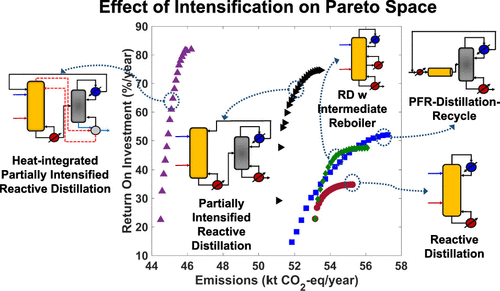当前位置:
X-MOL 学术
›
ACS Sustain. Chem. Eng.
›
论文详情
Our official English website, www.x-mol.net, welcomes your
feedback! (Note: you will need to create a separate account there.)
Sustainable Process Intensification Using Building Blocks
ACS Sustainable Chemistry & Engineering ( IF 7.1 ) Pub Date : 2020-11-19 , DOI: 10.1021/acssuschemeng.0c04590 Salih Emre Demirel 1 , Jianping Li 1 , Mahmoud El-Halwagi 1 , M. M. Faruque Hasan 1
ACS Sustainable Chemistry & Engineering ( IF 7.1 ) Pub Date : 2020-11-19 , DOI: 10.1021/acssuschemeng.0c04590 Salih Emre Demirel 1 , Jianping Li 1 , Mahmoud El-Halwagi 1 , M. M. Faruque Hasan 1
Affiliation

|
Process intensification (PI) is a design concept that offers innovative solutions for making a substantial improvement in terms of cost, energy efficiency, emission, environmental footprint, processing volume, and safety of a chemical process. Incorporation of PI principles at the conceptual design stage can pave the way for more sustainable solutions. However, it is not trivial to identify effective intensification pathways considering the various trade-offs between multiple conflicting performance metrics. To that end, we combine the building block-based systematic PI (Demirel, Li, and Hasan, Comp. Chem. Eng., 2017,150, 2–38) with the ε-constraint-based multiobjective optimization to synthesize both economically attractive and environmentally sustainable chemical process systems. We successfully apply this approach to discover several novel intensification pathways for an industrially relevant chemical process for ethylene glycol production. These new pathways suggest nonintuitive flowsheets involving partial intensification, as opposed to complete merging of reaction and separation phenomena. Partial intensification significantly increases the return on investment while reducing the indirect CO2 emissions when compared to traditional nonintensified and intensified designs.
中文翻译:

使用构件块进行可持续过程强化
工艺强化(PI)是一种设计理念,它提供了创新的解决方案,可以在成本,能源效率,排放,环境足迹,处理量和化学工艺安全性方面进行大幅改进。在概念设计阶段将PI原则纳入其中可以为更可持续的解决方案铺平道路。但是,考虑到多个相互冲突的绩效指标之间的各种权衡,确定有效的强化途径并非易事。为此目的,我们结合基于块的系统的建筑物PI(雷尔,李,和Hasan,小样。化学工程,2017年,150,2–38)和基于ε约束的多目标优化,以合成具有经济吸引力和环境可持续性的化学过程系统。我们成功地应用了这种方法,为工业上相关的乙二醇生产化学过程发现了几种新颖的强化途径。这些新途径表明涉及部分强化的非直观流程图,与反应和分离现象的完全合并相反。与传统的非强化和强化设计相比,局部强化可显着提高投资回报率,同时减少间接的CO 2排放。
更新日期:2020-12-07
中文翻译:

使用构件块进行可持续过程强化
工艺强化(PI)是一种设计理念,它提供了创新的解决方案,可以在成本,能源效率,排放,环境足迹,处理量和化学工艺安全性方面进行大幅改进。在概念设计阶段将PI原则纳入其中可以为更可持续的解决方案铺平道路。但是,考虑到多个相互冲突的绩效指标之间的各种权衡,确定有效的强化途径并非易事。为此目的,我们结合基于块的系统的建筑物PI(雷尔,李,和Hasan,小样。化学工程,2017年,150,2–38)和基于ε约束的多目标优化,以合成具有经济吸引力和环境可持续性的化学过程系统。我们成功地应用了这种方法,为工业上相关的乙二醇生产化学过程发现了几种新颖的强化途径。这些新途径表明涉及部分强化的非直观流程图,与反应和分离现象的完全合并相反。与传统的非强化和强化设计相比,局部强化可显着提高投资回报率,同时减少间接的CO 2排放。











































 京公网安备 11010802027423号
京公网安备 11010802027423号